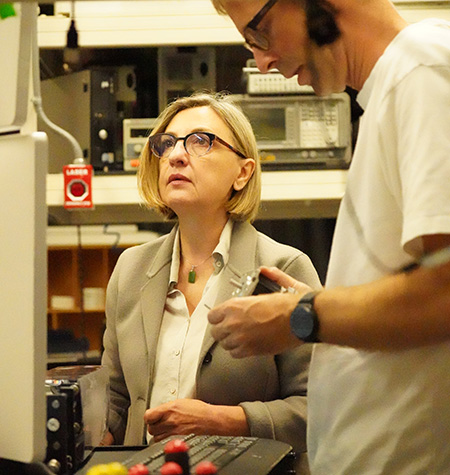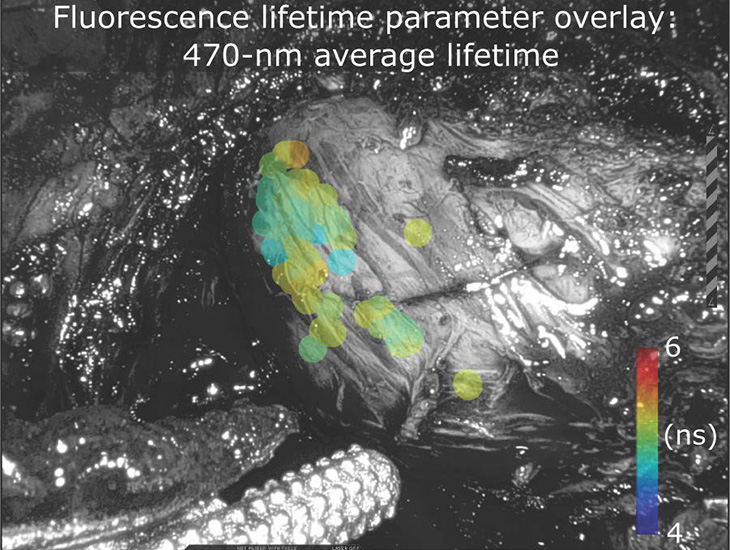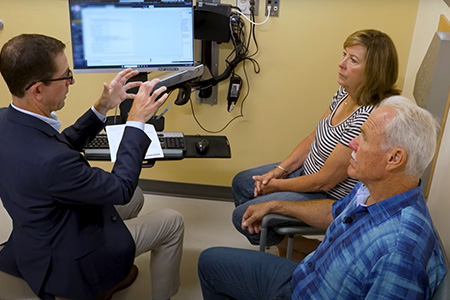A new imaging technology developed at UC Davis is set to revolutionize prostatectomy, the surgery to remove prostate cancer. This technology, called Fluorescence Lifetime Imaging (FLIm), helps surgeons preserve the prostate function after surgery, shorten the recovery time and avoid unneeded radiation.
Prostate cancer is the most common cancer in men. It affects around 1 in 8 men in the United States. Treatment usually includes a surgery (prostatectomy) to remove the tumor and radiation post-surgery.
About the FLIm technology
FLIm is an imaging technology that allows users to differentiate the tumor and its margins from healthy tissues. With clear margins, surgeons can cut only where needed. This results in less invasive cancer surgeries, easier recovery and fewer side effects for patients.
Laura Marcu, the director of The National Center for Interventional Biophotonic Technologies (NCIBT), has led the development of the FLIm technology. She is a professor of neurological surgery and biomedical engineering who runs a lab that is a pioneer in advancing label-free imaging technologies — those that don't need fluorescent dyes, tags or markers. One application of these technologies is in detecting tumors, especially during surgeries.

FLIm has already been tested and validated in brain cancer and in head and neck cancer surgeries. Now, researchers led by UC Davis urologic surgeon Marc Dall'Era are testing its power during prostate surgeries.
Prostate removal may lead to side effects, such as urinary incontinence and sexual dysfunction. Minimizing these effects depends on preserving the very small nerves and blood vessels that travel around the prostate.
"All cancers are unique, but prostate cancer is especially unique," said Dall'Era, professor and chair of the Department of Urologic Surgery. "When we're operating, our goal is to remove bad tissues while preserving as much of those nerves and blood vessels as possible to maintain function and enhance recovery."
In most cases, surgeons can't see the margins of a tumor with the naked eye. These margins are microscopic and found on the edge or within the prostate. Real-time assessment of the margins can help guide the surgery to preserve sexual and urinary function.
"The goal is to help surgeons better identify cancerous tissues during the operation," said Julien Bec, the engineering director at the Marcu Laboratory. "When surgeons identify the residual cancer tissue, they can achieve full resection with minimal removal of healthy tissue."

How does FLIm boost minimally invasive prostatectomies?
At UC Davis Health, surgeons perform prostatectomies using the da Vinci® system, a minimally invasive surgical robot. Adding FLIm to this technology would allow surgeons to use an endoscope to capture a live video feed and generate mixed-reality images. These images would show tissue differences, which help surgeons detect the tumor margins.

"Preserving healthy tissues can maximize functional recovery, preventing the loss of urinary or erectile function. It can also help reduce unneeded post-surgery radiation treatment," Dall'Era explained.
For this clinical trial, all participants will have surgeries powered by the FLIm technology. For now, the trial is set to enroll 20 participants.
"We are offering men undergoing prostatectomy at UC Davis Health the chance to participate," Dall'Era said. So far, he has operated on two patients using this combined technology. Dall'Era described the experience as 'fantastic.'






